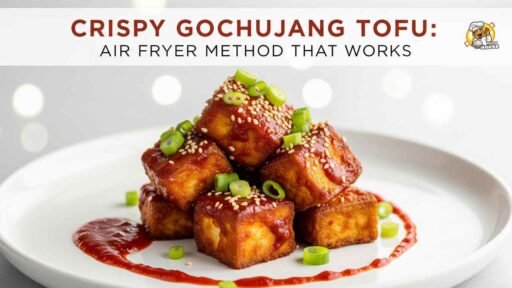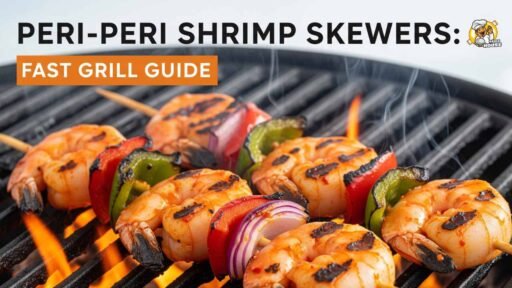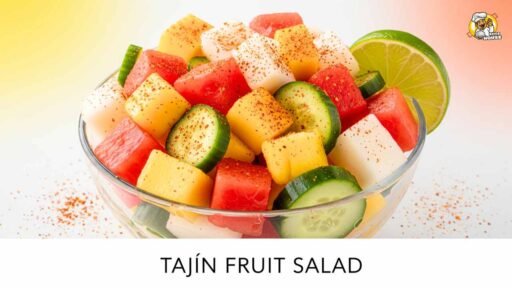Crispy gochujang tofu isn’t just another plant-based recipe. It hits that sweet spot: fiery, savory, and somehow still comforting. The crunch locks in flavor, while the gochujang glaze brings smoky heat balanced with subtle sweetness. This isn’t corporate “healthy eating” spin, it’s real food joy. Think weeknight quick meal, with restaurant-level taste. Honestly, this smells like dinner perfection before the pan even hits medium-high.
Instant Brands, the company behind Instant Pot and popular Vortex air fryers, filed for bankruptcy protection in 2023. That hard fact landed even as “air fryer” remained one of the most searched cooking terms in the U.S., and #airfryer content clocked tens of billions of views on TikTok. The contradiction points to a larger shift: hardware cycles are volatile, but air-fried, flavor-forward weeknight cooking has moved into the cultural center. Enter crispy gochujang tofu—fast, cheap, and punchy—a dish that’s quietly become a proxy fight for appliance makers, sauce companies, and grocers bidding for your basket.
Here’s the thing: gochujang isn’t new. Korean home cooks have leaned on this fermented chili paste for centuries. But its mainstream surge has big consequences. It affects appliance brands (Ninja, COSORI, Instant), sauce players (CJ Foods/Bibigo, Mother-in-Law’s, Trader Joe’s private label), and tofu companies (Pulmuone/Nasoya, Hodo) vying for repeat purchase. Consumers are the deciders, of course—busy, budget-conscious, and tired of limp tofu. But investors, retail buyers, and even restaurant chains now track whether crispy gochujang tofu is a sticky habit or a passing trend.
The Data:
-
According to Google Trends, U.S. search interest for “gochujang” has more than doubled since 2019, and “air fryer tofu” has trended at multi-year highs. Translation: discovery meets utility.
-
Circana (formerly NPD Group) estimates that roughly four in ten U.S. households now own an air fryer, with cumulative sales in the tens of millions since 2017. Penetration is high, usage is habitual, and the category still pulls share from ovens and stovetops.
-
Instacart’s Year in Groceries reporting has flagged Korean condiments as breakout items in the last two years, with gochujang orders rising by double digits year over year. Retail buyers we spoke with say velocity gains are strongest in 10–14 oz squeeze formats.
Quick Crispy Gochujang Tofu: Air Fryer Method that Works

If you want the TL;DR before the deep dive, here’s the fast playbook:
Ingredients:
- 14–16 oz extra-firm tofu, drained and pressed
- 2 tablespoons gochujang
- 1 tablespoon soy sauce or tamari
- 1 tablespoon neutral oil (avocado, canola)
- 1 tablespoon rice vinegar or lime juice
- 2 teaspoons honey, sugar, or maple
- 1 teaspoon garlic, grated
- 1 teaspoon ginger, grated (optional)
- 2–3 tablespoons cornstarch or potato starch
- Sesame seeds, scallions, and lime for serving
Steps:
- Press tofu 15–20 minutes. Cut into 1-inch cubes; pat very dry.
- Whisk gochujang, soy, oil, vinegar, and sweetener with garlic/ginger. Reserve 2 tablespoons for glaze.
- Toss tofu with remaining marinade; rest 10 minutes. Sprinkle starch and toss until every side looks dusty and tacky.
- Preheat air fryer to 390–400°F (200–205°C) for 3 minutes. Lightly oil the basket. Arrange tofu with space between pieces.
- Air fry 9–12 minutes, shaking halfway, until deep golden and crisp.
- Thin reserved sauce with a splash of water. Toss hot tofu in the glaze or drizzle on top. Finish with sesame, scallions, and a squeeze of lime.
Eat right away. The crust sings when hot.
Crispy Gochujang Tofu: Air Fryer Method that Works (Step By Step Guides)
1. Choose the Right Tofu and Prep It Like You Mean It
Crisp tofu starts at the shelf, not the basket. Reach for extra-firm or “super-firm” tofu that’s packed in water. The protein network in these blocks stands up to heat. Silken or soft tofu will tear and steam instead of crisping. If your store stocks vacuum-sealed super-firm tofu, you can skip pressing. For water-packed blocks, pressing is non-negotiable.
Drain the tofu and wrap it in a clean towel. Set a skillet or a few cans on top for 15–20 minutes. You don’t need a fancy press; gravity and patience do the work. The goal is simple: reduce surface moisture so the starch clings and the crust forms. Cut into 1-inch cubes for a good crisp-to-soft ratio. Smaller cubes crisp faster but risk drying out inside. Bigger pieces stay custardy but need more time.
Pro move if you plan: freeze, then thaw. Freezing changes the tofu’s structure, creating tiny pockets that drink in marinade and deliver a chewier bite. It’s a different texture—more nugget-like. Some love it, some don’t. Try both.
Before you marinate, pat the cubes dry again. This smells like overkill, but it isn’t. Excess water dilutes flavor and steams in the air fryer. Dry tofu equals better browning, better adhesion, better dinner. One more small thing: Preheat your air fryer. A hot basket sears on contact and prevents sticking. Little steps add up.
2. Build a Gochujang Marinade That’s Balanced and Sticky
Gochujang brings heat, umami, and a subtle funk from fermentation. But on its own, it’s thick and a little stubborn. You need balance to make it sing and to help it stick to tofu. Start with 2 tablespoons of gochujang, 1 tablespoon of soy or tamari for salt and depth, 1 tablespoon neutral oil to carry fat-soluble flavors, and 1 tablespoon rice vinegar or lime for acidity. Add 2 teaspoons of honey or sugar to round out the heat and aid caramelization. Grated garlic gives sharpness. Ginger is optional but bright.
Whisk until glossy. Taste it. If it’s too salty, add a touch more sweet or acid. If it’s flat, a dash of soy often fixes it. Reserve a couple of tablespoons for a finishing glaze. That’s your insurance policy after frying.
Now, the coating. Toss the tofu with the bulk of the marinade and rest 10 minutes. Then sprinkle in 2–3 tablespoons cornstarch or potato starch. Mix gently until every cube looks dusty and tacky. The starch hydrates on the surface and turns into a micro-crust in the air fryer. It’s the same principle that makes good fried chicken so addictive.
Why not add starch to the wet marinade upfront? Because it gums up. Starch needs to cling to the tofu, not dissolve in the bowl. Layering—marinade first, starch second—keeps surfaces sticky and the centers tender. If you want more crunch, do a second light dusting just before loading the basket. And yes, you can use rice flour or even fine panko in a pinch, but starch gives the most reliable crunch with less oil.
3. Nail Time, Temperature, and Air Flow (The Three Levers That Matter)
Air fryers aren’t ovens. They’re compact convection boxes with fast-moving air. That’s a feature, not a bug—if you use it well. Preheat at 390–400°F (200–205°C) for 3 minutes. A hot chamber sets the crust fast. Lightly oil the basket or use a perforated liner to reduce sticking. Space is the next lever. Overcrowding blocks air pockets and creates soggy sides. One layer, gaps between pieces, no stacking.
For 1-inch cubes, start at 10 minutes total. Shake at the 5–6 minute mark to flip surfaces to the airflow. At 8 minutes, peek. You’re hunting for deep golden edges, a rough surface, and an audible crisp when you tap a cube with tongs. If you see pale patches, go 2–4 minutes more. Every unit runs a little hot or cool. Ninja and COSORI baskets tend to run true to set temperature; some compact models don’t. Adjust once and you’ll know your machine’s personality.
Oil matters, but not much. A teaspoon tossed into the marinade helps with conductivity and color. Spraying at the start can help if your tofu is very lean. Resist spraying midway; you’ll often collapse the crust.
Two caveats. First, don’t chase a shatteringly hard shell. Tofu benefits from a thin, crisp layer and a creamy interior. Second, don’t walk away in the last two minutes. Starch goes from perfect to scorched fast near 400°F. If you hit your color early, drop to 360°F and hold for 2–3 minutes to drive off moisture without scorching. That trick buys you insurance.
4. Glaze Hot or Drizzle Smart and Season at the End
You reserved a couple of tablespoons of marinade, right? Thin it with a splash of water, a touch more vinegar if you like bright, and taste for salt. When the tofu is hot and crisp, you have two options.
Option A: Toss to coat. This gives a thin, glossy shell that clings. Work fast, using a big bowl to avoid breaking cubes. Add only enough sauce to coat. If you flood it, you’ll soften the crust—and undo your work.
Option B: Drizzle and finish. Plate the tofu plain, drizzle the glaze in zigzags, and let people drag pieces through it. This keeps the crust loud and gives diners control over heat and tang.
Finish with sesame seeds for nutty pop, thinly sliced scallions, and a squeeze of lime or a few drops of toasted sesame oil. On rice, add quick pickles—cucumber with rice vinegar, sugar, and salt—to cut the heat. In a rice bowl, layer shredded cabbage or warm greens for crunch and steam. In a wrap, add avocado for fat and kimchi for snap.
Pro tip: If you plan leftovers, keep the glaze on the side. Re-crisp the tofu at 375°F for 3–4 minutes the next day, then dress. You’ll get much closer to day-one texture. And yes, you can scale this. Two baskets going at once? Rotate them halfway so airflow stays even.
5. Variations, Swaps, Nutrition, and Troubleshooting
Gochujang heat levels vary by brand. Bibigo’s base paste leans moderate; artisanal brands can be hotter and funkier. Trust your tongue. If you need milder, stretch with ketchup or a bit of yogurt. If you want smokier, add gochugaru (Korean chili flakes) or smoked paprika. Gluten-free? Use tamari and check your gochujang label; some use barley malt. Many major brands now sell gluten-free versions.
No cornstarch on hand? Potato starch crisps are a touch lighter. Rice flour works; it’s just less glassy-crisp. Arrowroot can get slimy here—skip it. For sweetness, honey caramelizes beautifully; maple adds a rounder note; white sugar is clean and predictable. For acid, rice vinegar is softer; lime is brighter. Either way, keep the triangle balanced: heat, sweet, and acid.
Want protein variety? This same method rocks with tempeh (parboil 10 minutes to tame bitterness), extra-firm pressed paneer, or par-cooked cauliflower florets. For chicken, increase time to 12–15 minutes and ensure safe temp, but then we’re not talking tofu.
Troubleshooting:
-
Soggy? You overcrowded or skipped preheating. Give pieces more space and hot air.
-
Pale? You needed a touch more oil or sugar for color, or your machine runs cool. Add a minute.
-
Gummy coating? You mixed starch into the wet marinade instead of dusting after, or the tofu was wet. Dry more and layer the coating.
-
Too spicy? Mix in a spoon of yogurt or mayo, or drizzle honey on top. You can even stir a little gochujang into yogurt for a softer heat.
Nutrition-wise, you’re getting lean protein, fiber, and a short ingredient list. Air frying uses a fraction of the oil of deep frying. You’ll feel that in the dish and, likely, in your weekly grocery run.
The People
“A lot of folks think air fryers are magic,” said a veteran R&D chef who worked on basket design at a major appliance brand. “They’re not. They’re tiny, hot wind tunnels. If you crowd the basket, air can’t do its job. The best results come from preheat, spacing, and something starchy on the outside. That’s it. And tofu? It’s perfect for that.”
A regional grocery buyer told me the condiment set is already changing. “We reset Asian sauces last spring and doubled linear feet for Korean. Gochujang is now a top-10 sauce by velocity for us, right behind sriracha in some stores. Squeeze bottles matter for trial, and meal videos drive basket adds. When tofu spikes, gochujang moves with it.” Sources say even mainstream suburban stores are seeing repeat buys from shoppers who once called it “that red paste.”
On the brand side, a product lead at a national tofu company was candid. “The plant-based boom made a lot of noise, then meat analogues cooled. Tofu’s different—less processed, cheaper, and more versatile. When we demo crispy tofu with a bold sauce, conversion is immediate. The air fryer took the fear out of texture.”
The Fallout
So what happens when crispy gochujang tofu becomes the default midweek staple? First, winners and losers emerge. Appliance makers that build reliable, easy-to-clean baskets—Ninja’s drawers get praise for nonstick that lasts—keep daily mindshare. Brands that bet on clunky presets and complicated apps risk churn. Users don’t want another ecosystem. They want dinner in 20 minutes.
Second, the sauce players scale. CJ Foods, which owns Bibigo, already sits on global distribution and marketing muscle; it can push and squeeze gochujang into every aisle and bundle with frozen items. Challenger brands carve space with cleaner labels and bolder funk. Private label follows. Expect more “spicy Korean-style” sauces that nod but don’t quite say gochujang. That’s fine; trial still leads to the real thing.
Third, the plant-based aisle gets a reset. When tofu proves it can be crispy, saucy, and satisfying for less than $3 a serving, it undercuts higher-priced analogs on both value and experience. Analysts now predict steady tofu growth even as some alternative meats reset. Don’t be surprised if you see bundled promotions: tofu + sauce + rice packs in endcaps, ready for a one-scan dinner.
There’s also a supply story. Gochujang depends on gochugaru (Korean chili flakes), fermented grains, and time. If demand surges, pepper sourcing and fermentation capacity become bottlenecks. Smart brands will invest in local fermentation and transparent labeling to build trust, especially as “clean” and “authentic” stay in tension. Meanwhile, the soybean supply is robust, but quality and handling vary. Tofu texture starts at the plant. Upstream focus pays off.
Restaurants feel this, too. Casual spots already sell gochujang-glazed wings and crispy tofu bowls. As home cooks nail the method, restaurants must push harder on texture contrasts, plating, and hospitality. Or they lean into speed—think fast-casual bowls that scratch the same itch for busy families. Either way, the line between home and pro technique narrows when hardware and social video democratize know-how.
Investors should be sober. Not every viral dish translates into lasting sales. But watch the signals: repeat purchases of 10–14 oz gochujang, rising tofu velocities in mainstream grocers, and short-form video that shows not just plating, but the press-marinate-starch sequence. Those are habit indicators. And habit, not hype, is what moves categories from trend to baseline.
One more angle: health claims. Some brands pitch air frying as “guilt-free fried.” That’s a little thick. Air frying reduces oil use, yes, but it’s still a method that benefits from a bit of fat for flavor and absorption of fat-soluble nutrients. The better pitch is honest: faster, crispier, with less oil and less mess. Consumers can smell spin.
Closing Thought
We’ve been here before—sriracha summers, sheet-pan winters, Instant Pot mania. But crispy gochujang tofu is different because it’s a method that maps to many proteins, many nights, and many budgets. If Ninja, CJ Foods, and your local grocer all bet on that shift, the question is simple: will this fast, fiery staple lock in as the new Tuesday night default, or will the next shiny gadget break the habit before the sauce hits critical mass?






